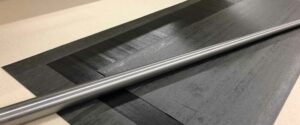Composite Rods and Tubes, Custom composites
The Art and Science Behind Roll-Wrapped Composite Tubes
Roll-wrapped composite tubing is structural tubing made by wrapping composite fabrics — such as carbon fiber or fiberglass — that have been pre-impregnated with resin around a mandrel. The layers are typically oriented in different directions to optimize strength and stiffness. After wrapping, the tubing is cured to bond the layers, resulting in a lightweight and strong cylindrical structure.
In this article, we will examine the intricacies of roll-wrapped composite tubes, examining the design and scientific principles behind their construction.
Unique Design Considerations for Roll-Wrapped Composite Tubing
Here are the different design considerations to ensure effective roll wrapping:
Fiber Orientation
Roll-wrapped composite tubing allows for control over the orientation of the fibers during the wrapping process. Engineers can tailor the tubing’s mechanical properties by aligning the fibers in each layer in different directions, such as axial, hoop, and ± 45° orientations. This unique flexibility enables the optimization of strength, stiffness, and other performance characteristics.

Fiber and Fabric Choice
Composite prepreg fabric can have fibers oriented unidirectionally (all fibers lined up along the length of the fabric) or woven in a twill pattern. The fibers themselves, in addition to being carbon, fiberglass, kevlar, or other, can also be low, intermediate, or high modulus (high stiffness). The properties of the finished composite tube are dependent upon the fiber choice and the orientation of the fiber in the fabric.
Resin System Selection
Different resin formulations offer varying properties, such as temperature resistance, strength, stiffness, and toughness. Engineers must consider processing requirements, environmental conditions, and cost when selecting the appropriate resin system for a given application. Moreover, advanced resin technologies can further enhance the performance and durability of composite tubing. Resin for roll-wrapped composite tubing is pre-impregnated into the composite fabric.
Layering Configuration

The layering configuration is essential for achieving the desired balance of properties, including strength, durability, and flexibility. Engineers can design complex layup configurations with multiple layers of different materials, thicknesses, and orientations. This allows for hybrid structures that maximize performance while minimizing weight and cost.
Mandrel Shape and Surface Finish
The mandrel plays a critical role in determining the composite tubing’s final shape and interior diameter. Engineers can utilize different mandrel shapes — cylindrical, tapered, or custom profiles — to achieve specific geometries and performance objectives. Additionally, the surface finish of the mandrel can influence the bonding between the layers and the overall quality of the tubing. Mandrels for wrapped composite tools are precision-ground and heat treated to minimize reject rates.
Scientific Principles Behind Roll-Wrapped Composite Tubing
The following principles guide the design, analysis, and optimization of roll-wrapped composite tubes:
Fiber Reinforcement
The primary scientific principle behind roll-wrapped composite tubing is the reinforcement of polymer matrix materials with high-strength fibers. These materials provide the tubing with excellent mechanical properties, including high strength-to-weight ratio, stiffness, and fatigue resistance. The orientation and arrangement of the fibers within the composite matrix also influence the tubing’s performance.
Lamination Theory
Roll-wrapped composite tubing relies on principles of lamination theory, which govern the behavior of laminated structures. According to this theory, the mechanical properties of composites are determined by the properties of their constituent layers and the orientation of the fibers. Engineers can minimize material usage and weight by carefully designing the layup configuration and fiber orientation.
Composite Manufacturing Processes
Precise tension and pressure control ensure uniform fiber placement and resin impregnation during the wrapping process. Therefore, understanding the rheological properties of the resin system and curing kinetics is crucial for achieving proper consolidation and bonding between the layers. In addition, factors like temperature and processing parameters influence the final properties of the composite tubing.
Mechanical Behavior
Principles of composite mechanics like elastic modulus, strength, and failure modes govern the mechanical behavior of roll-wrapped composite tubes. The material exhibits anisotropic behavior; its mechanical properties vary with direction due to the fiber orientation. Knowing how stress is distributed within the system is essential for predicting the tubing’s performance under different loading conditions.
Partner With Goodwinds Composites for Top-Notch Composite Manufacturing
Goodwinds Composites is a highly regarded American company specializing in creating custom composite materials. With our extensive knowledge and engineering expertise, we offer invaluable guidance and develop practical solutions tailored to your unique applications. Whether you require a basic tube or a complex structure, we are dedicated to meeting your needs.
Contact us today to learn more about our comprehensive products and services.

